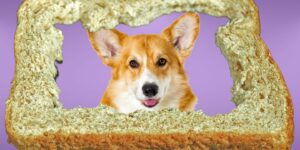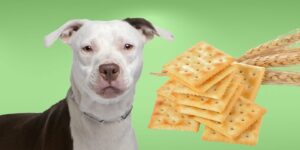Yes, dogs can eat bread in moderation as part of a well-balanced diet. However, some types of bread may be more beneficial for dogs than others.
Types of Bread
Whole grain bread
Whole grain bread is made from whole grains that have not been stripped of their natural nutrients, such as fiber, vitamins, and minerals. This type of bread is typically richer in nutrients and offers a range of health benefits for dogs.
White bread
White bread is made from refined flour that has had most of its natural nutrients removed. It tends to be less nutritious than whole grain bread and may contain additives or preservatives that can be harmful to dogs.
Multigrain bread
Multigrain bread contains a mix of different grains, such as wheat, oats, barley, and rye. This type of bread may provide a wider range of nutrients than white bread, but it is still important to choose whole grain varieties for the highest nutritional value.
Gluten-free bread
Gluten-free bread is made without wheat and is suitable for dogs with gluten allergies or sensitivities. However, some gluten-free breads may contain alternative grains or ingredients that could still cause an allergic reaction, so it is essential to read the labels carefully.
Nutritional Components of Bread
Carbohydrates
Bread is primarily made up of carbohydrates, which provide an important energy source for dogs.
Protein
Bread contains small amounts of protein, which is essential for building and maintaining healthy muscles, skin, and hair.
Fiber
Whole grain breads are good sources of dietary fiber, which can improve digestion and help maintain a healthy weight.
Vitamins and minerals
Whole grain breads are rich in essential vitamins and minerals, such as B vitamins and zinc, which contribute to overall health and wellbeing.
Additives and preservatives
Some breads may contain additives and preservatives that could be harmful to dogs. It is important to check the ingredient list and avoid feeding bread with potentially harmful ingredients.
Benefits of Bread for Dogs
Energy source
Carbohydrates found in bread provide a quick and easy source of energy for dogs.
Digestive health
The fiber found in whole grain bread can help promote healthy digestion and prevent constipation.
Weight management
When given in moderation, bread can be a low-calorie treat that helps with weight management.
Potential Health Issues with Bread
Allergies and sensitivities
Some dogs may be allergic or sensitive to wheat or other ingredients found in bread, resulting in symptoms such as vomiting, diarrhea, and skin issues.
Yeast and dough
Raw bread dough containing yeast can be dangerous for dogs, as the yeast can expand in their stomachs and cause bloating, pain, and potentially life-threatening complications.
High sugar and salt content
Some breads have high levels of sugar and salt, which can be harmful to dogs if consumed in large quantities.
Obesity and related health problems
Too much bread can contribute to weight gain and obesity, leading to a range of health issues such as diabetes, heart disease, and joint problems.
Safe Bread Alternatives for Dogs
Rice cakes
Plain rice cakes are a low-calorie, low-fat alternative to bread that can be served as a treat for dogs.
Plain popcorn
Air-popped popcorn without added salt, butter, or flavorings can also be a healthy treat for dogs.
Homemade dog treats
Making homemade dog treats using dog-friendly ingredients is a great way to ensure that your pet is getting a safe, nutritious snack.
Precautions When Feeding Bread to Dogs
Avoid feeding raw dough
Never feed raw bread dough to dogs, as the yeast can cause serious health problems.
Be mindful of bread ingredients
Check the ingredient list on store-bought bread and avoid any bread containing harmful additives, preservatives, or ingredients your dog may be sensitive to.
Start with small portions
Give your dog small amounts of bread initially, and monitor their reaction before increasing the portion size.
Monitor your dog's reaction
Keep an eye on your dog after feeding them bread, and watch for any signs of an allergic reaction or gastrointestinal issues.
Tips for Feeding Bread to Dogs
Remove crusts
The crust of bread can be difficult for some dogs to digest, so it is best to remove the crusts before feeding.
Choose whole grain bread
Opt for whole grain bread varieties, as they offer the best nutritional value for your dog.
Make sure the bread is fresh
Stale bread can become moldy and pose health risks to your dog, so ensure the bread is fresh before giving it as a treat.
Use bread as a treat, not a meal replacement
Bread should only make up a small part of your dog's diet and should never replace a balanced, nutritious meal.
When to Consult a Veterinarian
Signs of an allergic reaction
If your dog shows symptoms of an allergic reaction, such as vomiting, diarrhea, or skin issues, contact your veterinarian immediately.
Symptoms of gastrointestinal issues
Seek veterinary advice if your dog experiences bloating, pain, or other signs of gastrointestinal problems after eating bread.
Changes in weight or appetite
Consult your veterinarian if your dog experiences significant changes in weight or appetite, as this could indicate an underlying health issue.
Concerns about your dog's diet or nutrition
If you have concerns about whether bread is suitable for your dog's specific dietary needs, consult with a veterinarian for personalized recommendations.
Key Takeaways
- Bread can be a safe treat for dogs in moderation, as long as it doesn't contain harmful additives or ingredients.
- Whole grain bread is the healthiest choice for dogs and provides essential nutrients.
- Monitor your dog's reaction to bread and consult with a veterinarian if any adverse effects occur.











